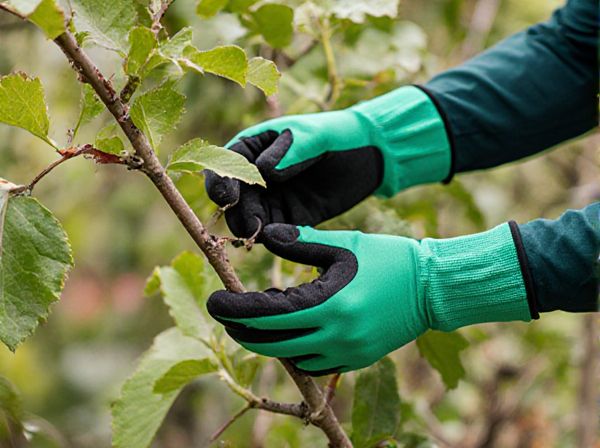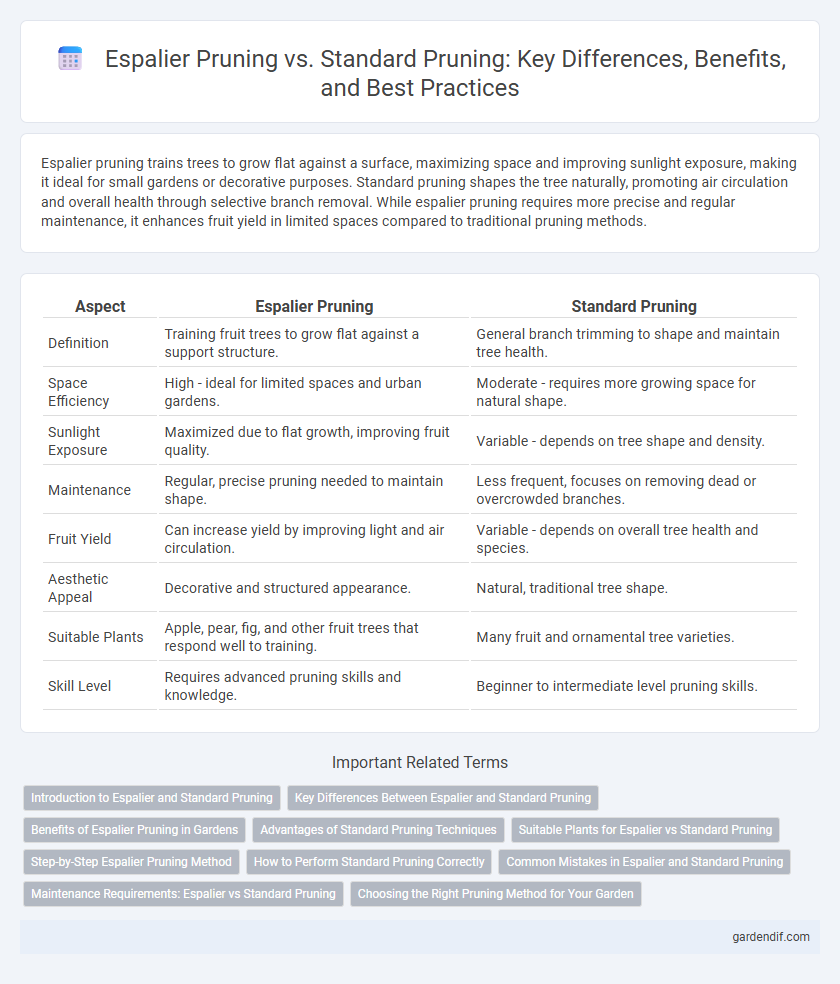
Espalier pruning vs standard pruning Illustration
Espalier pruning trains trees to grow flat against a surface, maximizing space and improving sunlight exposure, making it ideal for small gardens or decorative purposes. Standard pruning shapes the tree naturally, promoting air circulation and overall health through selective branch removal. While espalier pruning requires more precise and regular maintenance, it enhances fruit yield in limited spaces compared to traditional pruning methods.
Table of Comparison
| Aspect | Espalier Pruning | Standard Pruning |
|---|---|---|
| Definition | Training fruit trees to grow flat against a support structure. | General branch trimming to shape and maintain tree health. |
| Space Efficiency | High - ideal for limited spaces and urban gardens. | Moderate - requires more growing space for natural shape. |
| Sunlight Exposure | Maximized due to flat growth, improving fruit quality. | Variable - depends on tree shape and density. |
| Maintenance | Regular, precise pruning needed to maintain shape. | Less frequent, focuses on removing dead or overcrowded branches. |
| Fruit Yield | Can increase yield by improving light and air circulation. | Variable - depends on overall tree health and species. |
| Aesthetic Appeal | Decorative and structured appearance. | Natural, traditional tree shape. |
| Suitable Plants | Apple, pear, fig, and other fruit trees that respond well to training. | Many fruit and ornamental tree varieties. |
| Skill Level | Requires advanced pruning skills and knowledge. | Beginner to intermediate level pruning skills. |
Introduction to Espalier and Standard Pruning
Espalier pruning involves training trees to grow flat against a structure, optimizing space and enhancing fruit production by directing growth along a framework. Standard pruning focuses on removing dead or overgrown branches to maintain tree health and shape while allowing natural, three-dimensional growth. Espalier techniques require regular, precise cuts to maintain the framework, whereas standard pruning emphasizes strategic thinning for air circulation and sunlight penetration.
Key Differences Between Espalier and Standard Pruning
Espalier pruning involves training trees to grow flat against a surface, optimizing space in small gardens and enhancing sunlight exposure, whereas standard pruning focuses on shaping free-standing trees to maintain health and structure. Espalier techniques require precise, regular trimming to maintain the two-dimensional form, unlike standard pruning which allows more natural growth patterns. Key differences include growth habit control, space utilization, and aesthetic impact, with espalier prized for decorative and space-saving benefits.
Benefits of Espalier Pruning in Gardens
Espalier pruning maximizes garden space by training plants to grow flat against walls or trellises, making it ideal for small or urban gardens. This technique improves air circulation and sunlight exposure, leading to healthier plants and increased fruit production. Unlike standard pruning, espalier creates an aesthetically pleasing, structured appearance while facilitating easier harvesting and maintenance.
Advantages of Standard Pruning Techniques
Standard pruning techniques promote robust tree structure and enhance overall fruit yield by allowing natural growth patterns to develop. These methods improve air circulation and sunlight penetration, reducing the risk of diseases and encouraging healthier foliage. Compared to espalier pruning, standard pruning requires less precise training, making it more accessible for maintaining diverse orchard layouts and larger trees.
Suitable Plants for Espalier vs Standard Pruning
Espalier pruning suits plants with flexible branches and strong growth habits, such as apple, pear, and fig trees, enabling their training against flat surfaces for decorative and space-saving benefits. Standard pruning applies broadly to fruit trees, shrubs, and ornamental plants like roses and maples, focused on health, shape, and productivity without structural training. Selecting espalier pruning requires plants capable of adapting to controlled growth, while standard pruning accommodates a wider variety of species without extensive training needs.
Step-by-Step Espalier Pruning Method
Espalier pruning involves training fruit trees to grow flat against a structure, maximizing space and sunlight exposure, unlike standard pruning which shapes trees naturally. The step-by-step espalier pruning method begins by selecting young, flexible branches and securing them horizontally to a trellis or wire framework. Regularly remove vertical shoots and any unwanted growth, ensuring each main branch is evenly spaced and trained to maintain a balanced, two-dimensional shape for optimal fruit production.
How to Perform Standard Pruning Correctly
Standard pruning involves removing dead, diseased, or crossing branches to promote healthy growth and improve air circulation. Use sharp, clean tools to make precise cuts at a 45-degree angle just above a bud facing outward from the plant. Consistently prune during the dormant season, typically late winter or early spring, to minimize stress and encourage vigorous spring growth.
Common Mistakes in Espalier and Standard Pruning
Common mistakes in espalier pruning include improper selection of branches, resulting in poor framework and reduced fruit production, and failure to train branches along the support structure, causing uneven growth. Standard pruning errors often involve over-pruning, which weakens the plant, and incorrect timing that can stress trees or reduce flowering. Both techniques require careful attention to plant species, growth habits, and pruning stages to maximize health and yield.
Maintenance Requirements: Espalier vs Standard Pruning
Espalier pruning demands consistent, detailed maintenance including frequent tying and trimming to guide the branches along a flat plane, which can be labor-intensive compared to standard pruning. Standard pruning typically requires less frequent intervention and focuses on removing dead or overcrowded branches to maintain tree health and shape. The higher maintenance of espalier pruning supports its aesthetic and space-saving benefits, making it ideal for small gardens or urban settings.
Choosing the Right Pruning Method for Your Garden
Espalier pruning shapes plants against flat surfaces, maximizing space and sunlight exposure, ideal for small or urban gardens requiring neat, decorative growth. Standard pruning promotes natural plant forms, encouraging robust growth and fruit production while fitting larger or less structured garden designs. Selecting the right pruning method depends on garden space, desired plant aesthetics, and maintenance preferences to enhance health and yield effectively.
Espalier pruning vs standard pruning Infographic

 gardendif.com
gardendif.com